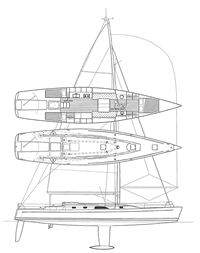Clarke 56
Racer-cruiserr
Students are fun. They can be frustrating and I have been accused of being "abusive." I probably deserve it. It's very important to me to have the student leave my office with tangible signs of progress. Despite the nuisance factor I will continue to take in students. I owe it to the industry. And it's enjoyable for me. Kids keep you young.
I can't ask students to work on ongoing office design projects so what I do is to lay out an independent assignment for them. Last summer Dan Clarke came from The Landing School in Maine. He arrived at the office early-that's important-appearing somewhat Gothic with very long hair, tatts and all-black garb. I knew I had a musician on my hands, so I was certain we would get along. I warned Dan of my abusive nature then laid out the assignment. "You are going to design my dream boat." I gave Dan a long list of parameters then sat back to watch the design progress over the next two weeks. I think when you look at the result of Dan's Landing School experience and his time in my office you will be impressed. Eric Goetz was impressed enough to hire Dan immediately. I was sorry to see Dan go.
The idea was a light and fast cruising boat for Puget Sound, almost a glorified daysailer. The hull shape shows a firm turn to the bulge to help with initial stability. The boat is narrow with an L/B of 4.66 so anything you can do to help stability is probably a good idea. Dan designed a keel drawing 9 feet with a bulb to further help stability. The near vertical transom is a good way to maximize both deck space and sailing length. This boat fits into what I call the "cruising sled" category.
The rig is fractional with a 110 percent working headsail. The jib is hanked on. This makes headsail changes easier. I like watching my wife scramble around on the spray-soaked foredeck changing jibs. The headstay tack is well aft of the stem. I asked for runners and checkstays because I like the idea of having lots of control over the mast bend. The mainsail roach just barely overlaps the standing backstay. The SA/D is 24, well below that of current hot rods, but enough to keep this boat moving well in light air. The shorter rig was chosen with an eye for stability.
I was emphatic in my accommodation requirements. Above all I wanted simplicity, with joinerwork details doing double duty as structural stiffeners. The big nav table has the reefer/freezer under it. There is a bulkhead-mounted wood burning stove to take the chill off the Northwest mornings. Just forward of the port quarter berth is a dedicated guitar locker. Main settees are extra long. I wanted elbow room.
The deck was designed around a big cockpit and tiller steering. Putting a tiller on a boat of this size is a bit of a stretch, but along with my fantasy for this design was the reality that my funds would be limited, so I thought a tiller would be cheaper than a wheel. If the boat is well balanced a tiller will work fine. Side decks are broad and there's a high enough seat back in the forward end of the cockpit to sit and be comfortable while reading. An open transom and swim step were included to make boarding the dinghy easy.

Comments